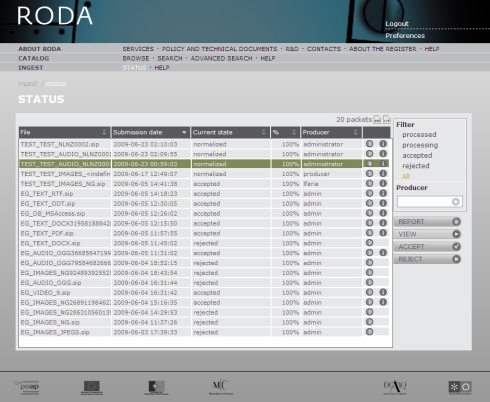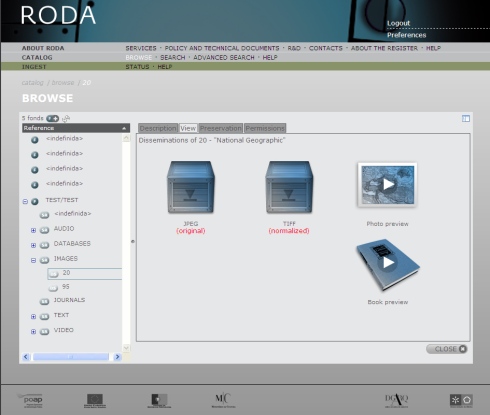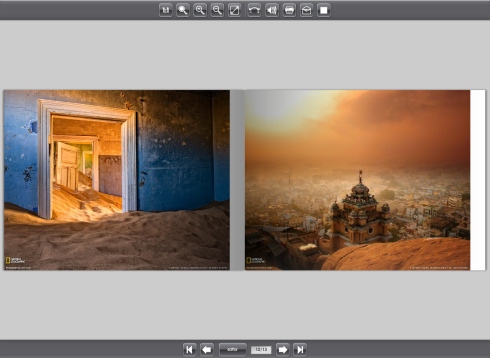RODA (Repository of Authentic Digital Objects) is a Portuguese initiative to preserve government authentic digital objects. It is based on Fedora Commons, and supports the preservation of text documents, raster images, relational databases, video and audio. It runs in Java on a suitable browser. RODA’s core preservation stragey is migration, but it keeps the original representation too, so it should be OK to open old files on emulated systems.
It’s in its final stages of preparation now; a demo is available at http://roda.di.uminho.pt/?locale=en#home. I’ve created the screengrabs below myself while exploring the demo.
My notes are very brief. If you go along to the demo you will discover that two of the PDF documents preseved there are papers explaining more about the principles, systems and strategy behind the RODA project.
RODA is OAIS-compliant, so let’s run through this in OAIS order.
The SIP: this comprises the digital original and its metadata, all inside a METS envelope which is then zipped. Preservation metadata is a PREMIS record and descriptive metadata is in a segment of EAD. Technical metadata would also be nice but RODA’s creators say it “is not mandatory as is seldom created by producers.”
Files included in the SIP are accompanied by checksums and are checked for viruses. Neatly, there are a number of ways that producers can create SIPs, one of which is a dedicated app called RODA-in.

Ingest. The system logs all SIPs which are in progress
Files in non-approved preservation formats (eg JPGs) are then normalised into formats which are approved (eg TIFFs). At that point they become AIPs. Approved formats are PDF/A for text (and for powerpoint presentations too, to judge from the examples on the demo), TIFF for images, MPEG-2 for video, WAV for audio, and DBML, this last one being an XML schema devised by the RODA team themselves for databases. Files in other formats are normalised by going through a normalisation plugin; “plugins can easily be created to allow ingestion of other formats not in the list.”
The AIP: if the archivist approves the SIP, and if it contains a normalised representation, then it becomes an AIP, and the customer can either search for it (simple search or a smart-looking advanced search) or browse the classification tree. The customer can view descriptive metadata, preservation metadata, previews of the data (depending on what sort of data it is) and the data itself.

Preservation metadata can be viewed as a timeline

An AIP. This is for a series of images; text documents, sound files etc all look different

Previews of specific images in the AIP
The photo and book-style previews are beautiful. I never knew Portugal looked like this 🙂
Security: currently the demo is open, but when it’s finally in action all users will be authenticated prior to accessing the repository, and all user actions will be logged. No anonymous users will be allowed. All preservation actions, such as format conversions, are likewise recorded. Permissions can be fine-tuned so that they apply from repository level all the way down to individual data objects. If a user does not have permission to view a specific item then it will not show in their search results.
And at the end of it all, the system can create stats!

The Administrator account can see stats
One thing which immediately strikes is the clean finish to its user interface, the RODA WUI layer (RODA Web User Interface). Very, very cool.
The Portuguese team has clearly put in a great deal of time and skill here. The project team is comprised of the Portuguese National Archives who carried out archiving consulting and development, the University of Minho which did the software engineering consulting, Assymetric Studios with design, the IDW with hardware, and Keep Solutions with maintenance and support.
My thanks to Miguel Ferreira of the University of Minho for answering my questions about RODA.


1 comment
Comments feed for this article
December 23, 2013 at 6:44 am
gurjendersihe2012
Thank you for sharing valuable information. Nice post. I enjoyed reading this post. The whole blog is very nice found some good stuff and good information here Thanks..Also visit my page the best wordpress themes.